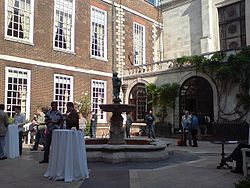Merchant Taylors' Hall, London: Difference between revisions
Created page with "{{Infobox building |name=Merchant Taylors' Hall |county=Middlesex |picture=Merchant Taylors Hall, the courtyard - geograph.org.uk - 813163.jpg |picture caption=The courtyard o..." |
|||
| Line 39: | Line 39: | ||
==Outside links== | ==Outside links== | ||
{{commons}} | |||
*[http://www.merchant-taylors.co.uk/ The Merchant Taylors] | *[http://www.merchant-taylors.co.uk/ The Merchant Taylors] | ||
Latest revision as of 22:40, 1 February 2019
| Merchant Taylors' Hall | |
|
Middlesex | |
|---|---|
 The courtyard of Merchant Taylors Hall | |
| Type: | Livery hall |
| Location | |
| Grid reference: | TQ32978118 |
| Location: | 51°30’50"N, 0°5’7"W |
| City: | London |
| History | |
| Built 1959 | |
| For: | The Worshipful Company of Merchant Taylors |
| Livery hall | |
| Information | |
| Owned by: | The Worshipful Company of Merchant Taylors |
Merchant Taylors' Hall is the seat and livery hall of the Worshipful Company of Merchant Taylors, one of the Twelve Great Livery Companies of the City of London surviving from the Middle Ages.
The Company has occupied its present site between Threadneedle Street and Cornhill since 1347.
History
The first Hall was built at some date between the years 1347 and 1392 when it was known as "Taillourshalle"; between then and the Great Fire of London in 1666, no records show structural alteration of any importance except the rebuilding of the roof between 1586 and 1588.
At the time of the Great Fire, the roof and the interior were gutted, leaving only the walls and foundations. The building was restored and embellished with tapestries, stained glass windows, chandeliers and panelling; but during the London Blitz in September 1940, it was hit by a number of German incendiary bombs and the Hall with both Galleries, the Western Entrance, the Grand Staircase and the Parlour with the Drawing Room above were destroyed.
Certain important parts of the premises, however, escaped damage. These included the library with its collection, inter alia, of early books, first editions and other interesting old volumes principally dealing with London; the Court Room, in which the walls are lined with portraits of Past Masters of the Company, and containing over the fireplaces two carved Coats of Arms representing the Company's original Grant of 1480 and the present Grant of 1586; the Great Kitchen, which has been in continuous use since 1425; and part of the Crypt of the late 14th century Chapel which adjoined the East end of the Hall.
Reconstruction
The work of reconstruction could not be started until some years after the end of Second World War and the Hall itself was opened for use in March 1959. Although the interior had been gutted, the walls and foundations had survived and have been incorporated in the restored Hall, which still retains the basic proportions of the previous building although the style of decoration has been radically changed. Prominent features are the mahogany panelling, the stained glass windows containing the Arms of Honorary Freemen and benefactors and the Renatus Harris organ.
The new floor of the Hall is almost at the same level as the parquet floor of 1793, and sections of the three previous floor levels - the 14th century beaten clay floor which was covered with rushes, the red tile floor laid in 1646 and the marble and Purbeck stone floor dated from 1675 - have been preserved and can still be seen in a trap in the floor.
The Company's collection of plates dates mainly from the 17th century as most of their earlier possessions were either sold or melted down during the Civil War to meet the King's demands for money, or were destroyed in the Great Fire of London. All that remains from these early days are the Corporate Seal of the Company (about 1502), the Cloth-yard (before 1509), the 16th century ceremonial mace and the "Offley" and "Maye" rosewater dishes of 1590 and 1597.
Accessibility
The Hall is open for housing public events through a dedicated events and catering company. It has been used for various purposes, ranging from entertainment industry photocalls such as for the Harry Potter film Harry Potter and the Goblet of Fire on 25 October 2005, to hosting official government and administrative events.
Outside links
| ("Wikimedia Commons" has material about Merchant Taylors' Hall, London) |
References
- The history and architecture of the Merchant Taylors' Hall: The Merchant Taylors' Company
